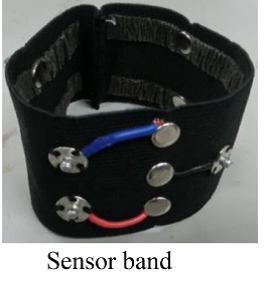Design of the PPy band. Credit: University of Electro Communications
Prostheses are used to replace body parts damaged through trauma or congenital deficiencies. A wide range of prosthetic limbs exist including myoelectric prostheses that operate by so-called surface electromyography (sEMG), where pulses of electrical voltage from muscles are relayed to sensors when users want to initiate a movement. However, a major problem limit the application of such prosthetic devices is the instability of the electrical signals measured.
Now, Yinlai Jiang and colleagues at the University of Electro-Communications, Tokyo, and collaborators in China, have developed sensors made of polypyrrole (PPy), a conductive polymer that is sewn onto elastic bands. The flexibility of these bands makes them much easier for patients to wear with one hand, and highly ergonomic.
The functionality of the sensors was tested by comparing the signals measured with the proposed sensor and those with traditional wet Ag/Agcl electrodes. Four subjects were recruited to wear sensors on their arms using both type of electrodes. Subsequently, signals measured by each kind of electrode when contracting the same set of muscles was measured. The quality of the signals measured in both cases had high correlation, indicating the functioning of PPy electrodes to be equivalent to traditional ones. Furthermore, prosthetic hands usually provide five basic motions and the recognition of each motion by the PPy sensor was also confirmed to be similar to traditional electrodes.
The PPy sensors are in direct contact with skin, in contrast to the wet electrodes that are covered by an electrolyte gel. This electrode-skin contact often exacerbates the source impedance or resistance in the circuit, masking the quality of signal. Balancing the source impedance however, restores the signal to noise ratio. The researchers conclude, "Source impedances, rather than the shape and the size of the electrodes, are important for sEMG measurement." This renders flexibility in the design of the PPy electrodes.
Ag/Agcl electrodes vs. PPy electrodes worn on similar regions of the arm. Credit: University of Electro Communications
The research team plans to expand this study with trials for a longer duration, and more patients. Given this study's promising results, the rigorous training, which patients must undergo to stabilize signals for myoelectric control, could be made much simpler in the future.
More information: Yinlai Jiang et al. sEMG Sensor Using Polypyrrole-Coated Nonwoven Fabric Sheet for Practical Control of Prosthetic Hand, Frontiers in Neuroscience (2017). DOI: 10.3389/fnins.2017.00033
Journal information: Frontiers in Neuroscience
Provided by University of Electro Communications
























